Botanical daffodils
This group includes wild species, forms and hybrids based on them (including terry ones). Daffodils of this class differ significantly in their requirements for cultivation conditions, and most of them are quite capricious. In warm climates, they make excellent pot plants for an alpine house. Most species reproduce by seed.
N. bulbocodium (N. brandushka)
The flowers of this variable species have very thin narrow yellow "petals" and relatively large, rounded expanding crowns. The leaves are like those of cereals. The plant requires moist, acidic soil that dries up in summer. In 3. Europe, it easily settles on lawns. In central Russia it winters, reproduces vegetatively, but does not bloom. In recent years, varieties have been created on the basis of this species, and more and more often they are singled out into a separate class.
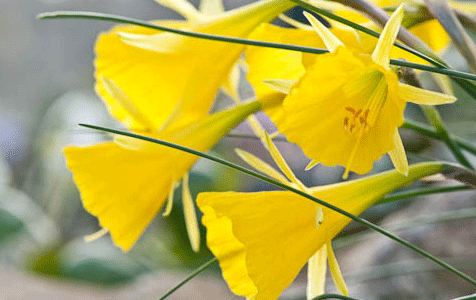 N. bulbocodium
N. bulbocodium
Cyclamineus (H. cyclamen)
View with narrow, saturated yellow crowns and long, completely bending "petals". On cool acidic soil in warm climates, this species reproduces by self-seeding. With equal success, it can be attributed to the class of Cyclamen daffodils. Height -25-30 cm.
 Cyclamineus
Cyclamineus
N. jonquilla (N. jonquil, N. sitnikovidny)
Up to four small golden-yellow flowers bloom usually later than most other daffodils - at the end of May or even in the second decade of June (according to observations in central Russia). This highly fragrant bloom grows well in well-drained limestone soil in full sun. The ancestor of the Jonquily class. Height - 30-40 cm.
 N. jonquilla
N. jonquilla
N. poeticus var. recurvus (syn. "Pheasant Eye")
White flowers with a strong aroma, with slightly bent "petals" and a small greenish crown inside with a red edge. This daffodil blooms later than most others - at the end of May. The most common botanical daffodil in Russia, which is also classified as Poetic. Lack of moisture in early summer can lead to weakened flowering the following year. There is an old double form that blooms in early June (“Double Pheasant Eye”). The elements of the crown are not expressed, the whole flower consists of many white tepals. Height - 36 cm.
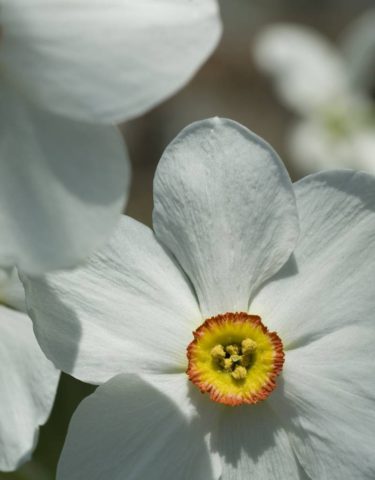 White flowers with a strong aroma
White flowers with a strong aroma
N. pseudonarcissus (N. false)
Narrow, twisted sulfur-yellow "petals" almost enclose the cream-colored crowns. This species needs not too dry soil; it may take several years for it to take root completely. If it is fixed in place, then it can reproduce itself, occupying large areas. Height - 25-36 cm.
 Narrow twisted sulfur-yellow "petals"
Narrow twisted sulfur-yellow "petals"
Triandrus (N. three-stalked)
The ancestor of the Three-spiked daffodil class, this species is often viewed with them. On the peduncle there are up to four flowers with a rounded crown and bent "petals". The species can take root in dry, acidic soil, or it can be grown in pots in an alpine house. Height-10-20 cm.
 Triandrus
Triandrus
Daffodils: varieties, origin

Daffodils: varieties, origin
Daffodils are monocotyledonous, perennial bulbous plants that belong to the Amaryllidaceae family. At the moment, more than 12 thousand varieties are known. Nobody could tell the exact place of their origin. Daffodils came to us from different countries. Most of them were created by Dutch breeders and in the dreams of the Mediterranean. But many were born in Asia, the United States of America and England.
For many centuries, this delicate flower has been considered a symbol of beauty and grace. There are many legends about him, poets composed poems in honor of him, artists painted on their canvases. In China, he is always present during the New Year celebrations.
Narcissus has an incredible intoxicating scent that attracts and does not let go. This is probably why perfumers like to use its oils and alkaloids to create their compositions. But oils are used not only for this, they are often used for medical purposes.
As for the legends, one of them tells about a young man in love with himself, who, seeing his reflection in the river, wanted to kiss himself. Throwing himself into the river, he drowned, and beautiful flowers grew in this place.
Description
Daffodils, despite their airiness, are very strong plants. The shape of their bulbs resembles a brown or golden egg, covered with scales. They have two buds that develop in different ways. The leaves of the plants are long and narrow. On the stems, both single and in some varieties, 4 flowers each can form. The shoots on which several inflorescences are formed at once, as a rule, are wrapped in a thin film and do not have leaves. The perianth, which protects the stamens, looks like a tube, which can be of various shapes, but always with a slight bend at the edges. In the center is a bell-shaped or bowl-shaped crown. It can be solid or cut out. Six stamens in two rows are attached at the top of the tube. The lower ovary is trihedral. The fruit is in the form of a capsule, which is divided into three parts. There are many seeds, but there are very few seeds. Their shape resembles a ball with a squirrel.
Daffodils have a very pleasant aroma that can fill the entire garden with their dope.
Description of species, shades and varieties
If you look at the photo gallery, you can not believe your eyes - daffodils, it turns out, are so different. And miniature, and lush, and bright, and aristocratic pale. Daffodils can be indoor and garden, large-crowned and small, domestic and wild. Consider the most interesting options for this plant.
Poetic. Such an interesting name is officially assigned to him. In natural nature, this flower grows in the mountains, near water sources. The plant is characterized by fast growth and very lush flowering. But it will develop and grow only in conditions of sufficient humidity and direct UV rays on the leaves.

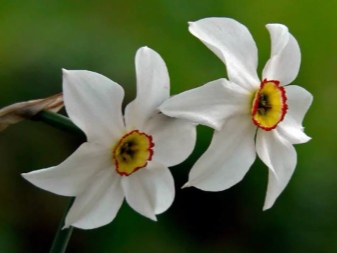
Flowering begins in the second half of May and lasts 2 weeks.


Blossoming of white daffodil occurs at the end of May. It lasts no more than 10 days.
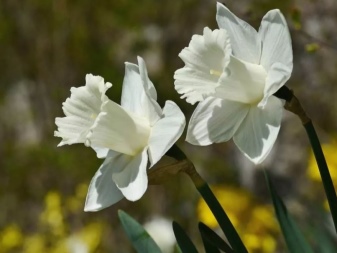

And this, of course, is not all. We can say that this is just the beginning of the story about daffodils. A flower classification assumes at least 12 plant species. And already each species is represented by a whole list of varieties.
Let's take a look at some of the plant species with the most popular varieties.
Tubular. Only one flower blooms on each peduncle, it can be both white and yellow. The maximum flower height is 45 cm. The well-known varieties are Glacier, Mount Hood, Dutch Master, Golden Harvest, Spelbinder.

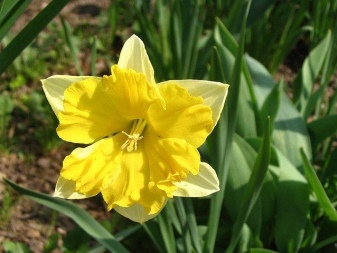

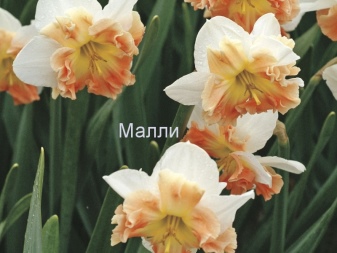
A separate group includes all those daffodils that cannot be described as belonging to any of the groups already described. A completely unusual look in the Peruvian daffodil, which, however, is often called a lily. Therefore, the choice of the grower is great
Beginning lovers of garden beauty should not ignore this culture, since there are no annual varieties of narcissus, all types are perennial. This simplifies the care of the plant, therefore it is not necessary to dig it out every year, in one place it spends from 2 to 5 years
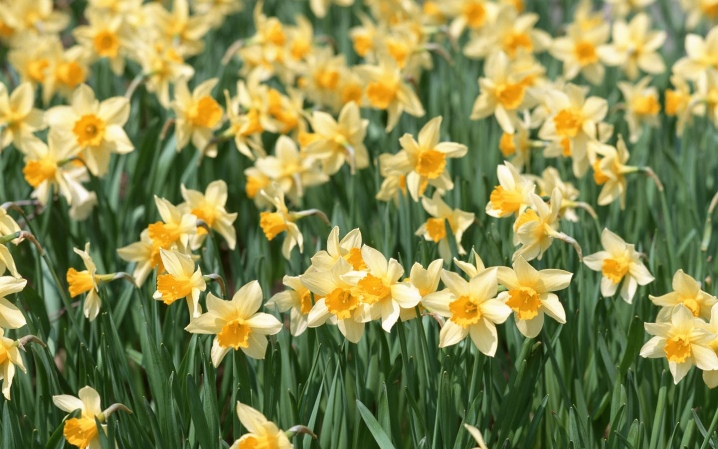
Daffodil care tips
- Daffodils are unpretentious. But if you plant them in heavily shaded areas under the trees, you should not expect a lush bloom. This perennial grows in any garden soil, the main thing is that it allows water to pass through well. To improve the permeability of clay soil, sand is added to it.
- Daffodils are planted in the fall. When planting in groups, select 6-12 bulbs of each variety per flower group. Rule of thumb: Plant at twice the height of the bulb. The spacing between plants is twice its diameter. Watering the bulbs after planting is optional.
- Remove the wilted peduncle after flowering. This will prevent the loss of energy required for seed formation. Save the leaves so that the bulbs accumulate nutrients.
Read the full text of the article in the issue of the magazine "COUNTRY. Style and way of life "for April-May 2015.
Photo: MSL / Josef Beeker, Ursel Borstell; Flora Press, GAP, Mauritius, Ulrike Romais, Suzanne Paus, Friedrich Strauss
Characteristic
Daffodils are perennial ornamental plants of the amaryllis family. The captivating flower is shrouded in an aura of secrets and ancient Greek legends. According to one of them, many hundreds of years ago, a beautiful and proud young man named Narcissus, seeing his reflection in the water surface, froze from his own beauty. The young man remained sitting on the bank of the stream until he died of endless narcissism. And in this place a refined and beautiful flower has grown, the bud of which is slightly inclined to the ground.


Each bulb produces 1-3 peduncles. The inflorescences are rather large - up to 10 cm in diameter. The coloring of daffodils is predominantly yellow or white. However, there are varieties with inflorescences of orange-red and pinkish shades. Two-tone daffodils are very popular. Such varieties look just amazing in group plantings. The height of most daffodils varies from 30 to 50 cm, there are also dwarf varieties, the length of which does not exceed 20 cm.
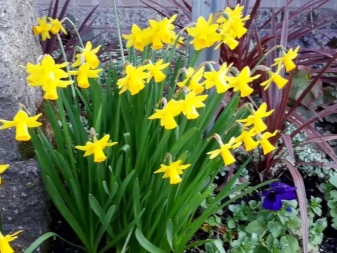

Narcissus flower - description
Daffodils in group plantings have a very picturesque appearance, because the dense rows of these plants during flowering are a beautiful sight. In nature, meadows of wild daffodils, for example, "Valley of daffodils" in the Carpathians, are protected by law and are considered a unique natural phenomenon.
The aroma of daffodils is also beautiful, and, how many varieties, so many shades of smell. It's not for nothing that the essence of narcissus has long been used in the perfume industry.
The daffodil plant belongs to the amaryllis family, which includes over 60 different types of bulbous perennials. Daffodils are widespread in the Mediterranean, China and Central Asia. They grow in a climate similar to ours, only with higher air humidity.
Daffodils have been cultivated since ancient times. They began to be bred in gardens even before our era, not only caring for them, but also deifying them. For some peoples, the daffodil is a symbol of the family. You can grow this beautiful symbol on your site without much effort - caring for daffodils is not particularly difficult.
Narcissus Tete-a-Tete
This variety of daffodil is classified as a cyclamen. It was bred as a separate culture in 1585. Plant height does not exceed 25 centimeters. There is one flower on the peduncle, which is very different from other species: the petals are sharply directed upwards, while the bud itself and the inner crown are lowered down. The color is bright yellow.
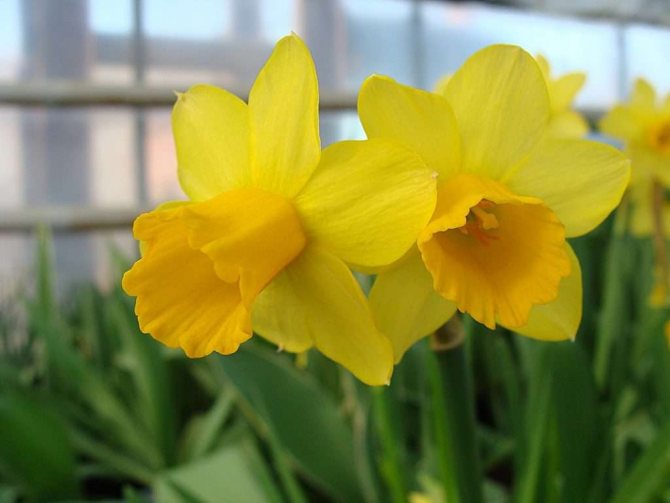
Flowering begins in early May, which is earlier than other varieties. The scent of the flower is pleasant
When leaving, it is important not to allow the soil to dry out too much, since this daffodil does not tolerate drought. Usually planted near curbs or low fences
Able to rapidly expand its population by releasing new ball-shaped bulbs. During the winter, the plant is dug out of the ground and stored in the basement until the onset of heat.
The best varieties of the split-crown group of daffodils
11. Split-crowned - have an original, split into several parts (usually 6) crown. The height of the peduncles, depending on the variety, ranges from 25 to 50 cm, the diameter of the flower is 7-11 cm, the diameter of the crown is 2.5-10 cm. Currently, this group of daffodils occupies a special place due to the variety of flower shapes.
According to the shape of the crown, 3 subgroups are distinguished:
1) the crown fits snugly against the petals;
2) does not adjoin the petals along the entire length, the lobes are curved, notched along the edge;
3) resembles a six-rayed star with narrow lobes.
Varieties:

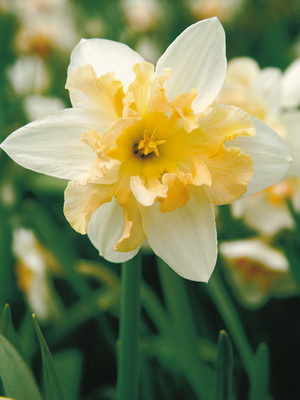
"Printl". The flower is 11.5 cm in diameter, the perianth is white, the crown is yellow with an unusually beautiful "curly" (fringed) edge. The flower resembles an orchid in shape.
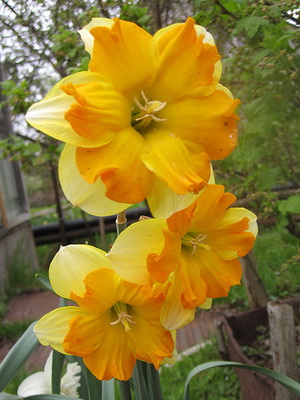
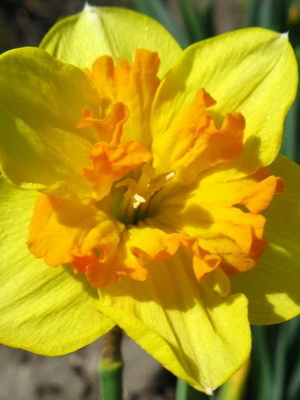
Mondragon.A flower 10.5 cm in diameter with a bright yellow perianth, a dark orange crown, corrugated. Medium, versatile.
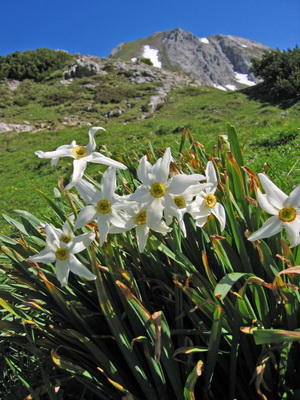

"Riesling". The flower is 9.5 cm in diameter, light lemon yellow, the crown is split almost to the base with a corrugated edge. Medium late. It is mainly used for cutting.


Royal Hayness. A flower 10 cm in diameter with a white perianth, a yellow-orange crown, curly, corrugated, with a wavy edge. Medium, versatile.

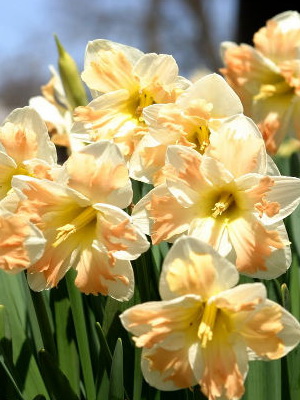
"Sanker". Flower 11.5 cm in diameter with a creamy white perianth, azalea crown, light cream with a wavy edge, 9 cm in diameter. Medium, universal.

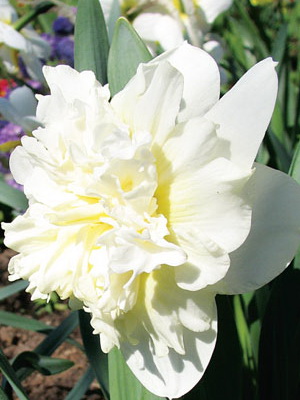
Silver Shell. A flower 10-11 cm in diameter with a white perianth, a large crown (8.5 cm), soft cream, corrugated. Early, versatile.


Sovrin. The flower is 8-9 cm in diameter with a white perianth, the crown is bright orange, corrugated. Medium, versatile.
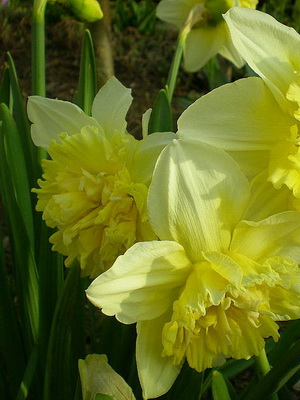

Flyer. A very spectacular one-color bright yellow flower (11-12 cm), curly crown, corrugated with outgrowths. Medium late, versatile.
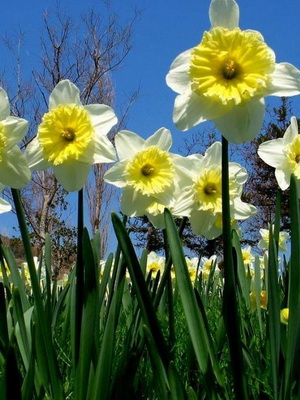

Egard. A flower 10.5 cm in diameter with a white perianth and a lemon-yellow crown. Late, versatile.

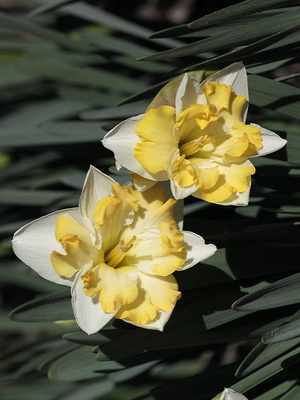
Etincelant. Flower with a diameter of 10 cm with a white perianth, azalea crown, creamy pink. Medium late, versatile.
12. This group includes all other daffodils not included in the previous groups.
Amazing "terry" representatives. Group 4
It includes terry daffodils, varieties of which are of extraordinary beauty. The stem of such a plant is decorated with one or several flowers at once. The crown of such daffodils is terry. The whole flower can have the same feature. Daffodils in the fourth group are outwardly different from each other, having different shapes and sizes. Their color is yellow, white, pinkish, orange or yellow-red. There are varieties and petals combined in color.

1. Acropolis. It is a white daffodil with a residual red crown. 2. Outer Space. It has white petals and a pink crown. 3. Chirfupness. Fully double-headed white daffodil 4. Flower Drift. White flower with orange crown. 5. Golden Ducat. A huge bright yellow terry daffodil. 6. Texas. Yellow double flower 7. Tahiti. Yellow terry daffodil with a red crown. Terry daffodils are very beautiful. Varieties of this group are used for garden decoration, forcing and cutting.
Terry daffodils
Most varieties of double daffodils are imported from South America. The plant loves a humid climate and does not tolerate prolonged drought. This group includes several types of daffodils, varieties with a photo, name and description are presented below.
On this topic:
BACK
FORWARD
1 of 2
Gay Challenger
A low-growing plant with dark green leaves 0.5 centimeters wide. On each peduncle there is 1 flower of extraordinary beauty. During the flowering period, the double daffodil has a yellow flower with a bright orange crown, uneven in size. The bud size can exceed 7 centimeters. Flowers decorate bouquets, it has no equal when cutting. It begins to bloom at the end of May.
Variety Texas
Belongs to the group of terry daffodils. The flower is large in size, has a double crown. The color is white - yellow or pale pink. Narcissus is unpretentious in cultivation. Loves rich and moist soil. Brought from Germany and Italy. The flower has been introduced into cultivation since 1565. Texas is great for group boarding. Suitable for decorating flower arrangements, may not fade for a long time without water when cut.
Terry daffodil of the Texas variety has an aromatic fragrance during the flowering period from mid-May. When wintering cold, it is better to cover.
Narcissus Ice King
The plant was bred in Italy and has been planted by gardeners since 1850. Narcissus Ice King reproduces vegetatively. The bulb of an adult plant does not exceed 5 centimeters. What does a daffodil look like?
The photo shows the flower family. The plant has wide leaves located below and at the level of the bud.Each peduncle has one white flower with a light yellow crown. Narcissus Ice King is distinguished by large flowers, the size of which reaches 11 centimeters.
Garden plots are ennobled with a flower, it is used in flower arrangements. Narcissus Ice King begins to bloom from the beginning of May. Will delight the gardener with beautiful flowers until the end of the month.
What does a Tahiti daffodil look like?
The plant has large double flowers reaching a size of 10 centimeters. The color of the main petals is light yellow. Inside there is a red - orange crown. Narcissus Tahiti grows up to 35 centimeters during the period of active growth. It has narrow dark green leaves that are located below the buds. Each flower has a separate peduncle.
The plant reproduces vegetatively, grows in areas near the house. It tolerates direct sunlight well, loves moist soil. It grows well in groups. It has been actively growing since mid-May. By the end of flowering it fades, but does not lose its pleasant aroma.
Narcissus Replit
The plant reproduces vegetatively. It tolerates sunlight well and can grow in the shade of trees. The plant has wide leaves of a dark green color, located at the level and below the inflorescences. There can be several buds on one pedicel. Large-sized flowers with light pink petals. The crown is terry, with a peach tint. The plant reaches a height of 50 centimeters. Narcissus Replit is used for landscaping garden plots.
Narcissus Rip Vann Winkle
The flower can be located and bloom, being in an open area and in the shade of trees. A low-growing plant, reaching a maximum length of 30 centimeters. It has wide leaves that do not grow to flowers. Narcissus Rip Van Winkle grows in moist and rich soil, does not tolerate drought. Flowers and crowns are double, bright yellow. Each peduncle has a single bud. The plant is dug up after flowering and planted in open ground at the end of winter.
Narcissus Obdam
The plant belongs to the terry group. Narcissus Obdam has a delicate and refined aroma. Flowers are located on a separate pedicel. They have a delicate beige shade. Large buds. When unfolded, they can exceed 10 centimeters. The plant grows large. At the end of active growth, it can exceed 50 centimeters.
The bulbs are planted in fertilized soil at the end of summer. In early spring, the daffodil Obdam begins to sprout from the ground. In mid-May, the plant pleases others with its appearance. The flowering period lasts no more than 12 days. By the end of this period, the flowers fade to a white hue, but do not lose their delicate aroma. Gardeners are advised to plant tubers in open sunny areas or in the shade of trees.
The tubers of the plant are large enough, up to 6 centimeters. Narcissus Obdam is planted in garden plots in groups.


